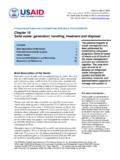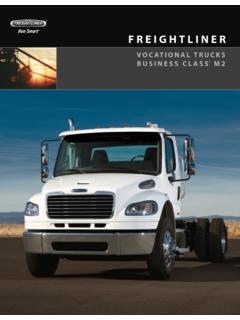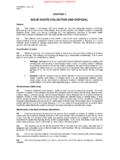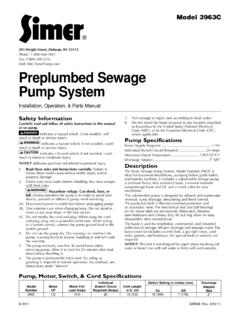Transcription of Manual handling in refuse collection HSL/2002/21 …
1 Broad Lane, Sheffield, S3 7 HQTelephone: +44 (0)114 289 2000 Facsimile: +44 (0)114 289 2500 Crown copyright 2002 Manual handling in refuse collectionHSL/2002/21 Human Factors GroupAndrew DJ Pinder PhD and Ed Milnes MScDr Andrew PinderProject Leader:SummaryObjectives1. To review scientific literature on Manual handling operations in refuse To identify risk factors for musculoskeletal disorders in refuse collection in an urbanenvironment. A variety of collection systems for domestic and trade waste werestudied including the collection of recyclable waste in wheeled bins andnon-recyclable waste in bags and wheeled To provide recommendations for methods of reducing the risks of musculoskeletaldisorders in refuse Findings1. A significant body of, largely European, scientific literature exists on manualhandling in refuse The findings of the literature are consistent with the observations made in this refuse collection and recycling practices vary between and within A wide range of factors, such as terrain, architecture, road layouts and traffic, thehabits of drug addicts, local feeling on wheelie bins, and time of day, can affect thekind of Manual handling operations carried out in refuse refuse collectors use a variety of methods to make their task easier, such as sendingcrew members ahead of the vehicle to gather refuse bags into Coding of postures using OWAS showed that overall.
2 Stressful postures wereadopted for small percentages of time with almost all falling into Action Category 1,which is deemed to not require action to reduce the risks from Manual handling of refuse sacks usually involves handling several sacks at once, heldand carried separately in each hand. refuse collectors generally use stoopingpostures to pick up bags. Stooping and twisting postures occur frequently but theoverall duration of each one is very Typical weights of domestic refuse sacks are between 4 and 6 kg. Fewer than 10%weigh more than 12 kg. It is rare that a sack weighs more than 20 kg. 9. refuse sacks are usually thrown onto the back of the vehicle rather than being liftedand placed into it. This is a dynamic action usually carried out while the worker isstill Throwing bags into a refuse lorry requires the lifting of the hands above theshoulders, though this occurs for relatively short The heights at which bags have to be thrown into refuse lorries (the rave heights )are such that approximately half of the male working population would haveproblems throwing the heaviest bags into the Bag handling occurs at a moderately high frequency with approximately 7 lifts,carries and throws per minute during periods of actual collection of refuse in bags can be hazardous due to the presence of sharp objects such as brokenglass or discarded syringes.
3 There are also hazards from foul or infectious On some occasions the old style of round non-wheeled dustbin are still manuallylifted and emptied into the refuse A variety of sizes of wheelie bin are used by business premises and large residentialbuildings, ranging from the domestic 240 litre size to 1100 litre Eurobins and Paladinbins. Some business premises bag their refuse in preference to a wheelie bin There is a general move from Paladins to Eurobins since they are easier to handlemanually and do not require specialised clamping systems for mechanical local authorities have installed bulk refuse storage systems that are emptiedmechanically without any Manual Pushing and pulling virtually never occur on rounds dealing with refuse in amounts of pushing and pulling occur on rounds dealing with wheeliebins.
4 Pulling of bins is slightly more common than pushing Even on rounds that are ostensibly dealing solely with wheeled bins, significantmanual handling of refuse bags and other loose refuse also refuse collectors walk considerable distances each day. Apart from when travellingin the refuse lorry, their lower limb postures are largely standing or The cardiovascular demands of the different methods of refuse collection do notappear to be excessive for normally fit workers. Main Recommendations1. Wherever possible, refuse collection should be carried out using wheelie bins ofappropriate sizes rather than bags or small As Government policy is to increase the amount of waste recycled, partly through thetaxation of landfill, schemes which encourage householders to separate recyclablewaste will become more common.
5 Where recycling collections are made by localauthorities or their contractors, separate wheelie bins should be provided The schedules of recycling / no-recycling collections should be matched to therelative volumes of recyclable and non-recyclable material to keep the volumescollected approximately Where use of wheelie bins is impractical, collection of bags is likely to continueunless bulk collection facilities can be implemented. In these circumstancesrecycling should be encouraged by the provision of green bins and Old-style dustbins should never be emptied manually into refuse vehicles. Wherehouseholders still use them they should be encouraged to line them with black bagsbefore putting refuse into Eurobins should be:a. Handled by two people whenever possible;b.
6 Transported across dropped kerbs wherever possible and particularly when beingreturned after emptying which is when most of the pulling back up kerbs wouldusually When moving any size of bin the refuse collectors should:a. Ensure there is sufficient space to manoeuvre the bin by moving surroundingobstacles, opening doors, Try to avoid pushing or pulling the bin across obstacles such as steps and Seek assistance when having trouble moving a bin - particularly if moving it upor down a slope or kerb or Manufacturers should be encouraged to consider the following changes / aspects ofthe bins:a. Increasing wheel diameter; b. Use of lightweight materials - especially in the larger 360 and 1100 Where possible, lorries without lifting gear and with a low rave height should beprovided for rounds dealing solely with bags.
7 Where the same vehicles are used fordifferent rounds, consideration should be given to demounting the lifting gear for thebags-only Where lifting gear is fitted, the rave bar should be lowered when not collectingwheelie bins. This recommendation should only be ignored if specific safety risksthat outweigh the Manual handling risks of keeping the bar up can be The refuse collectors should be involved in a scheme with the relevant localauthorities to identify areas where improvements could be made to their workenvironment. This would consider where kerbs should be dropped, ramps installed,alleys and pavements resurfaced and rubble or building waste refuse collectors and local residents / trade proprietors should all be involved inschemes to reduce the refuse collectors workload.
8 The refuse collectors couldidentify the premises and types of problems they face, , fetching bins from thebacks of shops, etc. Suggestions could then be made to residents / proprietors abouthow they can refuse collectors should be provided with effective PPE for their hands and would not only help reduce the risk of lacerations, infections and disease but itmay also enable refuse collectors to grip, hold and carry refuse in optimal ways, ,held in a balanced way and not held so far away from the legs. rate Trade round (bins / bags).. Green bin Bags Sizes of object handled on the trade Use of the hands in handling Type of object being Types of handling operations carried of analysis of handling Assignment of postures to OWAS Action Leg postures / Positions of hands relative to the Trunk of posture Assignment of postures to OWAS Action Posture rate of bag of the refuse collection rounds Other methods of refuse Trade Domestic Systems of refuse term effects of changes in working Physical capacity of refuse Psychosocial on health and fitness / survival in the and load on the low Laboratory study of refuse collection Study of actual working Effect of changing
9 Work Daily workload of refuse Comparison of dustbins and black demands of refuse health problems in refuse Resident / proprietor Physical environment Lowering the rave rail on the refuse environment changes (lift height, kerbs, steps, etc.).. to the design of wheelie to methods of refuse handling risk control and additional health Kerbs, steps and Manoeuvring bins in restricted of wheelie Throw in height of the truck ( rave height ).. Trunk twisting and raising the arms above shoulder Stooping while picking up handling of round Weights of risk Trade round (bins / trade sacks).. Green wheelie bins Bags 28. Summary of heart rate 27. Risk assessment for handling wheelie 26.
10 Risk assessment for handling of 25. OWAS Action Categories assigned to 24. Details of video recorded (times are in hh:mm:ss)..23 Table 23. Percentages of time in a posture and OWAS assignments toAction 22. OWAS Action 21. Assignment of postures to Behavioural Classes / 20. Details of the rounds 19. Combinations of jobs studied by Kuijer et al. (1999)..15 Table 18. Forces at the hands when handling a 240 litre wheelie bin(from Table 1 of Schibye et al., 2001a)..12 Table 17. Daily number of events for the three methods of refusecollection. Data from Table 4 of de Looze et al. (1995)..11 Table 16. Data from Table 3 of de Looze et al. (1995) on significanceof effects on spinal loading in different methods of 15. Variables studied for 1100 litre metal wheelie bins( containers ).














